Holmesglen: Contract Risk Evaluation in Tender Documentation AS4120
VerifiedAdded on 2023/06/04
|10
|3009
|98
Report
AI Summary
This report provides a comprehensive evaluation of contract risks associated with compiling tender documents, referencing the AS4120 Code of Tendering. It identifies potential risks from both the client's and contractor's perspectives, detailing how these risks can affect project outcomes. The report also outlines relevant Australian standards for tendering, particularly AS 4301 for design and construction contracts, and explains the obligations of the principal at various stages of the tendering process. Furthermore, it covers accepted procedures for closing and evaluating tenders, the obligations of tenderers, and examples of malpractice. The analysis includes specific references to a request for tender (Appendix 1), identifying contract requirements, specialist requirements, and practical solutions for associated risks, with a list of information sources used in the evaluation. This document is useful for students looking for solved assignments.
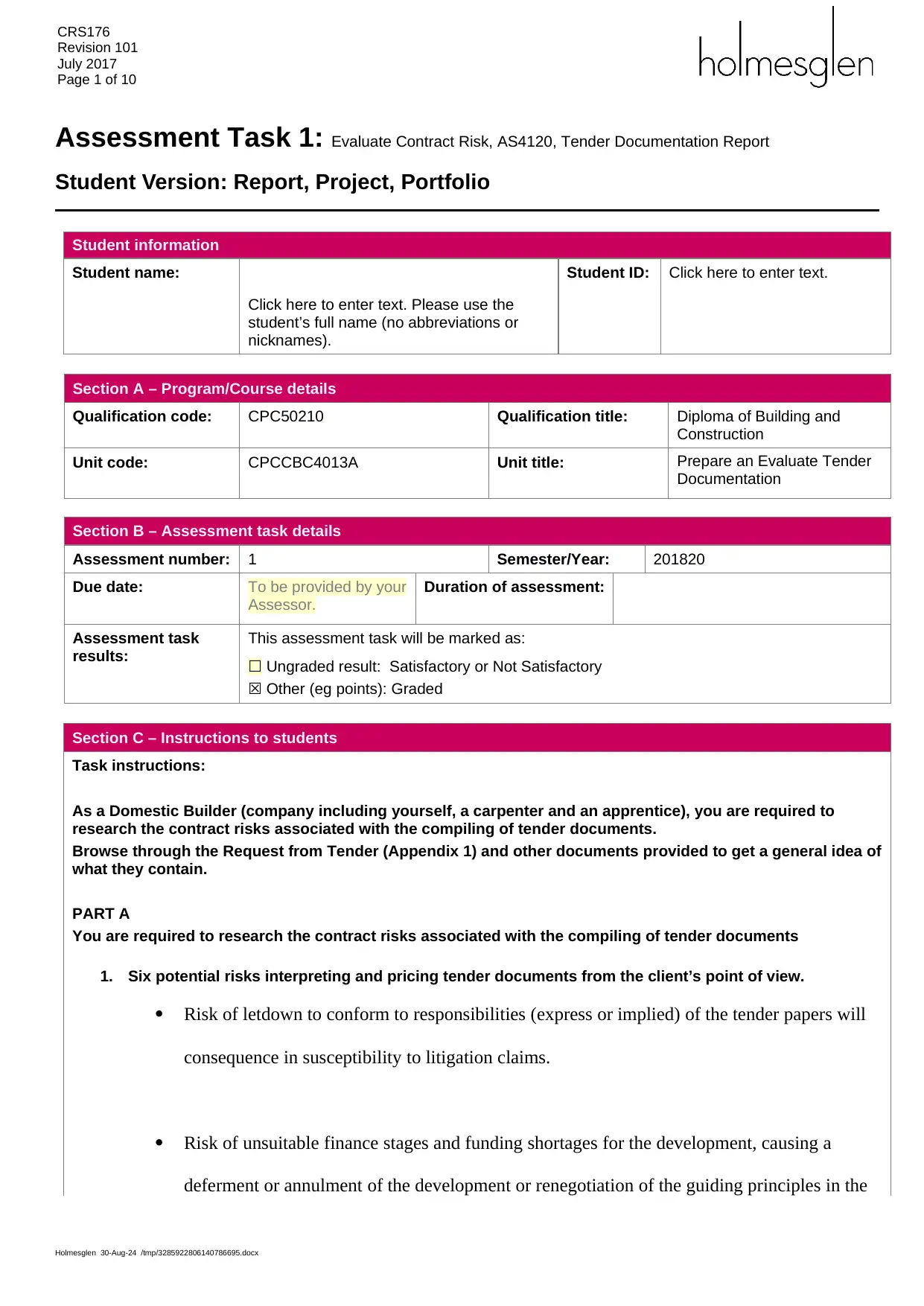
CRS176
Revision 101
July 2017
Page 1 of 10
Assessment Task 1: Evaluate Contract Risk, AS4120, Tender Documentation Report
Student Version: Report, Project, Portfolio
Student information
Student name:
Click here to enter text. Please use the
student’s full name (no abbreviations or
nicknames).
Student ID: Click here to enter text.
Section A – Program/Course details
Qualification code: CPC50210 Qualification title: Diploma of Building and
Construction
Unit code: CPCCBC4013A Unit title: Prepare an Evaluate Tender
Documentation
Section B – Assessment task details
Assessment number: 1 Semester/Year: 201820
Due date: To be provided by your
Assessor.
Duration of assessment:
Assessment task
results:
This assessment task will be marked as:
☐ Ungraded result: Satisfactory or Not Satisfactory
☒ Other (eg points): Graded
Section C – Instructions to students
Task instructions:
As a Domestic Builder (company including yourself, a carpenter and an apprentice), you are required to
research the contract risks associated with the compiling of tender documents.
Browse through the Request from Tender (Appendix 1) and other documents provided to get a general idea of
what they contain.
PART A
You are required to research the contract risks associated with the compiling of tender documents
1. Six potential risks interpreting and pricing tender documents from the client’s point of view.
Risk of letdown to conform to responsibilities (express or implied) of the tender papers will
consequence in susceptibility to litigation claims.
Risk of unsuitable finance stages and funding shortages for the development, causing a
deferment or annulment of the development or renegotiation of the guiding principles in the
Holmesglen 30-Aug-24 /tmp/3285922806140786695.docx
Revision 101
July 2017
Page 1 of 10
Assessment Task 1: Evaluate Contract Risk, AS4120, Tender Documentation Report
Student Version: Report, Project, Portfolio
Student information
Student name:
Click here to enter text. Please use the
student’s full name (no abbreviations or
nicknames).
Student ID: Click here to enter text.
Section A – Program/Course details
Qualification code: CPC50210 Qualification title: Diploma of Building and
Construction
Unit code: CPCCBC4013A Unit title: Prepare an Evaluate Tender
Documentation
Section B – Assessment task details
Assessment number: 1 Semester/Year: 201820
Due date: To be provided by your
Assessor.
Duration of assessment:
Assessment task
results:
This assessment task will be marked as:
☐ Ungraded result: Satisfactory or Not Satisfactory
☒ Other (eg points): Graded
Section C – Instructions to students
Task instructions:
As a Domestic Builder (company including yourself, a carpenter and an apprentice), you are required to
research the contract risks associated with the compiling of tender documents.
Browse through the Request from Tender (Appendix 1) and other documents provided to get a general idea of
what they contain.
PART A
You are required to research the contract risks associated with the compiling of tender documents
1. Six potential risks interpreting and pricing tender documents from the client’s point of view.
Risk of letdown to conform to responsibilities (express or implied) of the tender papers will
consequence in susceptibility to litigation claims.
Risk of unsuitable finance stages and funding shortages for the development, causing a
deferment or annulment of the development or renegotiation of the guiding principles in the
Holmesglen 30-Aug-24 /tmp/3285922806140786695.docx
Paraphrase This Document
Need a fresh take? Get an instant paraphrase of this document with our AI Paraphraser
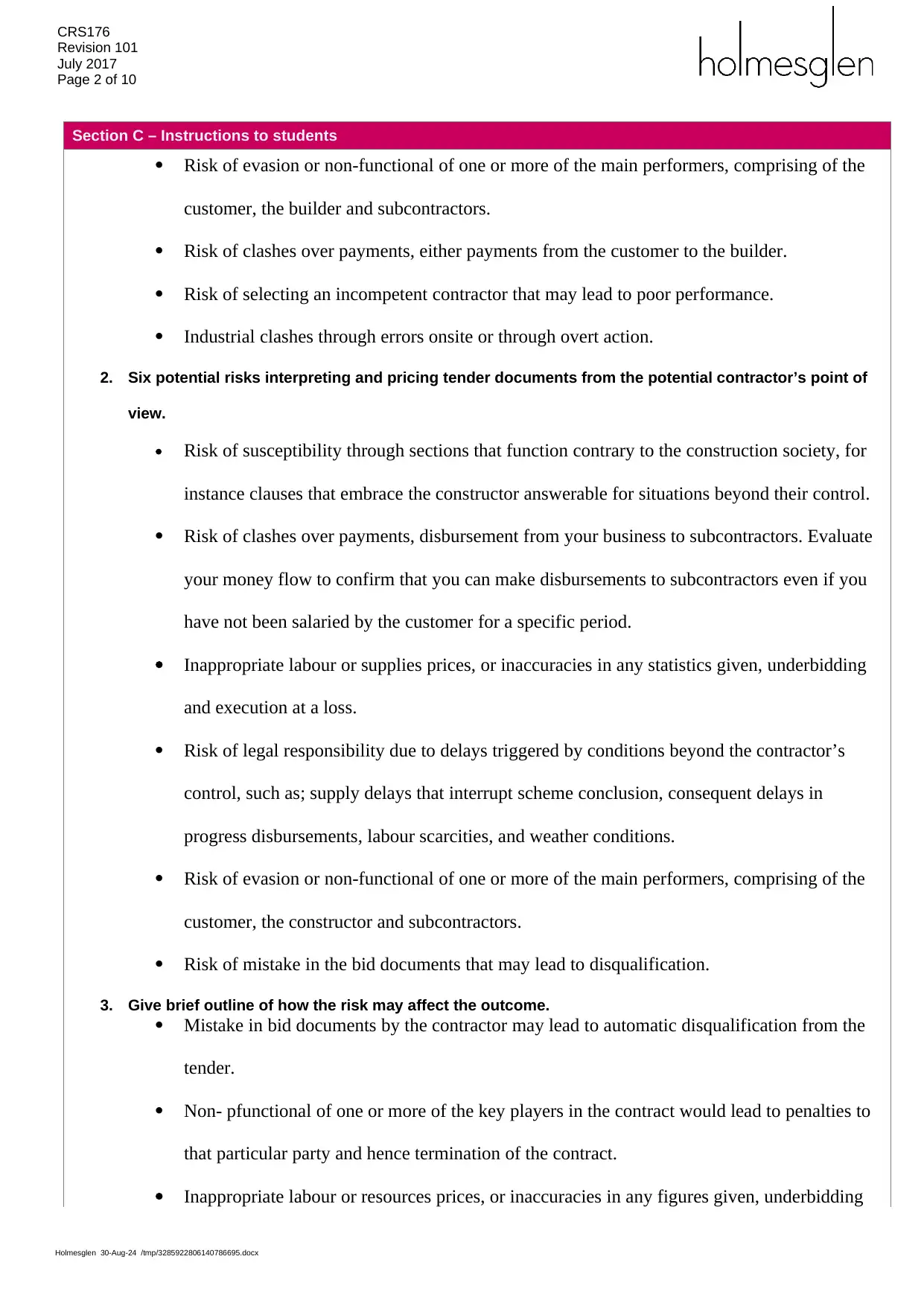
CRS176
Revision 101
July 2017
Page 2 of 10
Section C – Instructions to students
Risk of evasion or non-functional of one or more of the main performers, comprising of the
customer, the builder and subcontractors.
Risk of clashes over payments, either payments from the customer to the builder.
Risk of selecting an incompetent contractor that may lead to poor performance.
Industrial clashes through errors onsite or through overt action.
2. Six potential risks interpreting and pricing tender documents from the potential contractor’s point of
view.
Risk of susceptibility through sections that function contrary to the construction society, for
instance clauses that embrace the constructor answerable for situations beyond their control.
Risk of clashes over payments, disbursement from your business to subcontractors. Evaluate
your money flow to confirm that you can make disbursements to subcontractors even if you
have not been salaried by the customer for a specific period.
Inappropriate labour or supplies prices, or inaccuracies in any statistics given, underbidding
and execution at a loss.
Risk of legal responsibility due to delays triggered by conditions beyond the contractor’s
control, such as; supply delays that interrupt scheme conclusion, consequent delays in
progress disbursements, labour scarcities, and weather conditions.
Risk of evasion or non-functional of one or more of the main performers, comprising of the
customer, the constructor and subcontractors.
Risk of mistake in the bid documents that may lead to disqualification.
3. Give brief outline of how the risk may affect the outcome.
Mistake in bid documents by the contractor may lead to automatic disqualification from the
tender.
Non- pfunctional of one or more of the key players in the contract would lead to penalties to
that particular party and hence termination of the contract.
Inappropriate labour or resources prices, or inaccuracies in any figures given, underbidding
Holmesglen 30-Aug-24 /tmp/3285922806140786695.docx
Revision 101
July 2017
Page 2 of 10
Section C – Instructions to students
Risk of evasion or non-functional of one or more of the main performers, comprising of the
customer, the builder and subcontractors.
Risk of clashes over payments, either payments from the customer to the builder.
Risk of selecting an incompetent contractor that may lead to poor performance.
Industrial clashes through errors onsite or through overt action.
2. Six potential risks interpreting and pricing tender documents from the potential contractor’s point of
view.
Risk of susceptibility through sections that function contrary to the construction society, for
instance clauses that embrace the constructor answerable for situations beyond their control.
Risk of clashes over payments, disbursement from your business to subcontractors. Evaluate
your money flow to confirm that you can make disbursements to subcontractors even if you
have not been salaried by the customer for a specific period.
Inappropriate labour or supplies prices, or inaccuracies in any statistics given, underbidding
and execution at a loss.
Risk of legal responsibility due to delays triggered by conditions beyond the contractor’s
control, such as; supply delays that interrupt scheme conclusion, consequent delays in
progress disbursements, labour scarcities, and weather conditions.
Risk of evasion or non-functional of one or more of the main performers, comprising of the
customer, the constructor and subcontractors.
Risk of mistake in the bid documents that may lead to disqualification.
3. Give brief outline of how the risk may affect the outcome.
Mistake in bid documents by the contractor may lead to automatic disqualification from the
tender.
Non- pfunctional of one or more of the key players in the contract would lead to penalties to
that particular party and hence termination of the contract.
Inappropriate labour or resources prices, or inaccuracies in any figures given, underbidding
Holmesglen 30-Aug-24 /tmp/3285922806140786695.docx
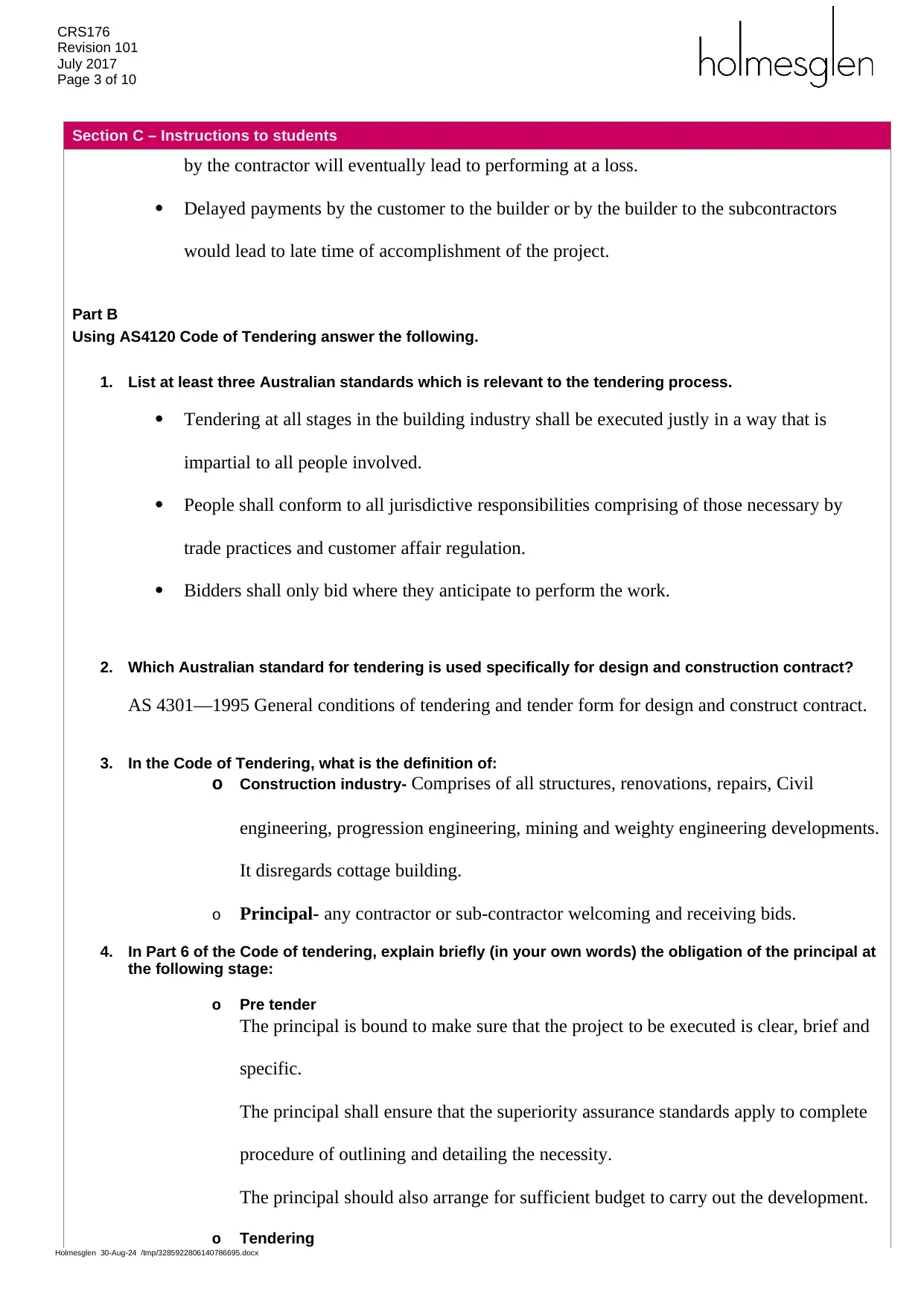
CRS176
Revision 101
July 2017
Page 3 of 10
Section C – Instructions to students
by the contractor will eventually lead to performing at a loss.
Delayed payments by the customer to the builder or by the builder to the subcontractors
would lead to late time of accomplishment of the project.
Part B
Using AS4120 Code of Tendering answer the following.
1. List at least three Australian standards which is relevant to the tendering process.
Tendering at all stages in the building industry shall be executed justly in a way that is
impartial to all people involved.
People shall conform to all jurisdictive responsibilities comprising of those necessary by
trade practices and customer affair regulation.
Bidders shall only bid where they anticipate to perform the work.
2. Which Australian standard for tendering is used specifically for design and construction contract?
AS 4301—1995 General conditions of tendering and tender form for design and construct contract.
3. In the Code of Tendering, what is the definition of:
o Construction industry- Comprises of all structures, renovations, repairs, Civil
engineering, progression engineering, mining and weighty engineering developments.
It disregards cottage building.
o Principal- any contractor or sub-contractor welcoming and receiving bids.
4. In Part 6 of the Code of tendering, explain briefly (in your own words) the obligation of the principal at
the following stage:
o Pre tender
The principal is bound to make sure that the project to be executed is clear, brief and
specific.
The principal shall ensure that the superiority assurance standards apply to complete
procedure of outlining and detailing the necessity.
The principal should also arrange for sufficient budget to carry out the development.
o Tendering
Holmesglen 30-Aug-24 /tmp/3285922806140786695.docx
Revision 101
July 2017
Page 3 of 10
Section C – Instructions to students
by the contractor will eventually lead to performing at a loss.
Delayed payments by the customer to the builder or by the builder to the subcontractors
would lead to late time of accomplishment of the project.
Part B
Using AS4120 Code of Tendering answer the following.
1. List at least three Australian standards which is relevant to the tendering process.
Tendering at all stages in the building industry shall be executed justly in a way that is
impartial to all people involved.
People shall conform to all jurisdictive responsibilities comprising of those necessary by
trade practices and customer affair regulation.
Bidders shall only bid where they anticipate to perform the work.
2. Which Australian standard for tendering is used specifically for design and construction contract?
AS 4301—1995 General conditions of tendering and tender form for design and construct contract.
3. In the Code of Tendering, what is the definition of:
o Construction industry- Comprises of all structures, renovations, repairs, Civil
engineering, progression engineering, mining and weighty engineering developments.
It disregards cottage building.
o Principal- any contractor or sub-contractor welcoming and receiving bids.
4. In Part 6 of the Code of tendering, explain briefly (in your own words) the obligation of the principal at
the following stage:
o Pre tender
The principal is bound to make sure that the project to be executed is clear, brief and
specific.
The principal shall ensure that the superiority assurance standards apply to complete
procedure of outlining and detailing the necessity.
The principal should also arrange for sufficient budget to carry out the development.
o Tendering
Holmesglen 30-Aug-24 /tmp/3285922806140786695.docx
⊘ This is a preview!⊘
Do you want full access?
Subscribe today to unlock all pages.

Trusted by 1+ million students worldwide
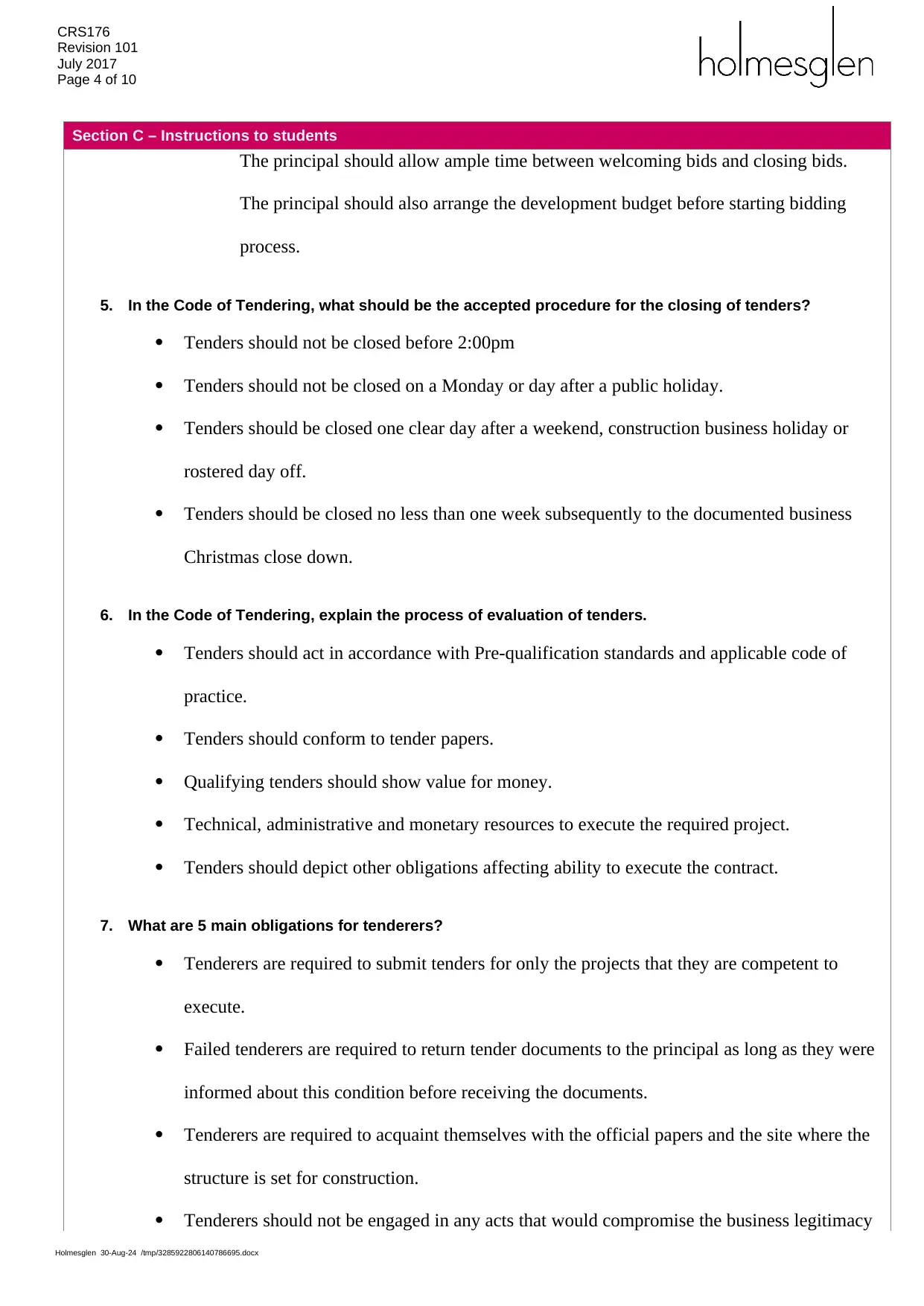
CRS176
Revision 101
July 2017
Page 4 of 10
Section C – Instructions to students
The principal should allow ample time between welcoming bids and closing bids.
The principal should also arrange the development budget before starting bidding
process.
5. In the Code of Tendering, what should be the accepted procedure for the closing of tenders?
Tenders should not be closed before 2:00pm
Tenders should not be closed on a Monday or day after a public holiday.
Tenders should be closed one clear day after a weekend, construction business holiday or
rostered day off.
Tenders should be closed no less than one week subsequently to the documented business
Christmas close down.
6. In the Code of Tendering, explain the process of evaluation of tenders.
Tenders should act in accordance with Pre-qualification standards and applicable code of
practice.
Tenders should conform to tender papers.
Qualifying tenders should show value for money.
Technical, administrative and monetary resources to execute the required project.
Tenders should depict other obligations affecting ability to execute the contract.
7. What are 5 main obligations for tenderers?
Tenderers are required to submit tenders for only the projects that they are competent to
execute.
Failed tenderers are required to return tender documents to the principal as long as they were
informed about this condition before receiving the documents.
Tenderers are required to acquaint themselves with the official papers and the site where the
structure is set for construction.
Tenderers should not be engaged in any acts that would compromise the business legitimacy
Holmesglen 30-Aug-24 /tmp/3285922806140786695.docx
Revision 101
July 2017
Page 4 of 10
Section C – Instructions to students
The principal should allow ample time between welcoming bids and closing bids.
The principal should also arrange the development budget before starting bidding
process.
5. In the Code of Tendering, what should be the accepted procedure for the closing of tenders?
Tenders should not be closed before 2:00pm
Tenders should not be closed on a Monday or day after a public holiday.
Tenders should be closed one clear day after a weekend, construction business holiday or
rostered day off.
Tenders should be closed no less than one week subsequently to the documented business
Christmas close down.
6. In the Code of Tendering, explain the process of evaluation of tenders.
Tenders should act in accordance with Pre-qualification standards and applicable code of
practice.
Tenders should conform to tender papers.
Qualifying tenders should show value for money.
Technical, administrative and monetary resources to execute the required project.
Tenders should depict other obligations affecting ability to execute the contract.
7. What are 5 main obligations for tenderers?
Tenderers are required to submit tenders for only the projects that they are competent to
execute.
Failed tenderers are required to return tender documents to the principal as long as they were
informed about this condition before receiving the documents.
Tenderers are required to acquaint themselves with the official papers and the site where the
structure is set for construction.
Tenderers should not be engaged in any acts that would compromise the business legitimacy
Holmesglen 30-Aug-24 /tmp/3285922806140786695.docx
Paraphrase This Document
Need a fresh take? Get an instant paraphrase of this document with our AI Paraphraser
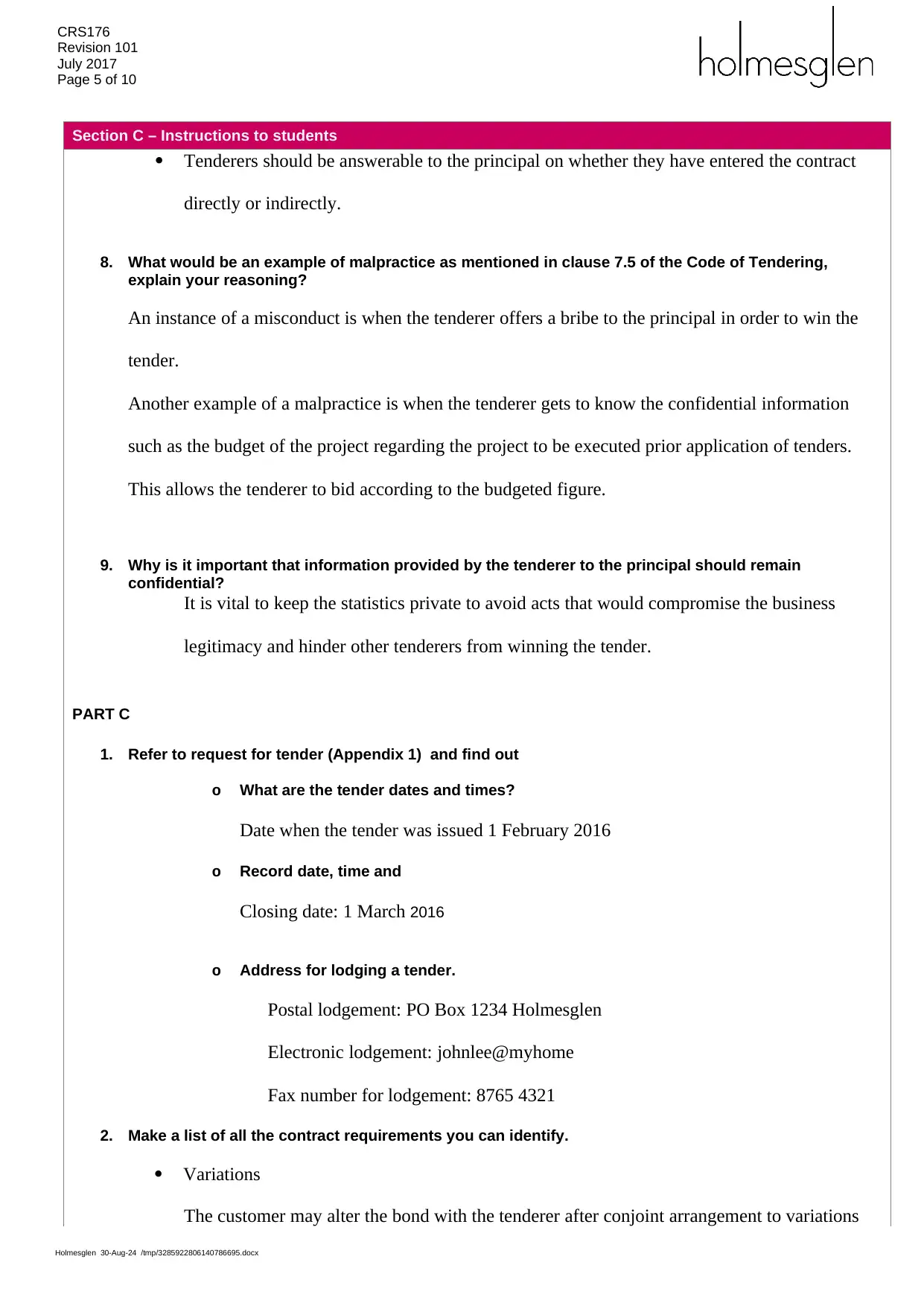
CRS176
Revision 101
July 2017
Page 5 of 10
Section C – Instructions to students
Tenderers should be answerable to the principal on whether they have entered the contract
directly or indirectly.
8. What would be an example of malpractice as mentioned in clause 7.5 of the Code of Tendering,
explain your reasoning?
An instance of a misconduct is when the tenderer offers a bribe to the principal in order to win the
tender.
Another example of a malpractice is when the tenderer gets to know the confidential information
such as the budget of the project regarding the project to be executed prior application of tenders.
This allows the tenderer to bid according to the budgeted figure.
9. Why is it important that information provided by the tenderer to the principal should remain
confidential?
It is vital to keep the statistics private to avoid acts that would compromise the business
legitimacy and hinder other tenderers from winning the tender.
PART C
1. Refer to request for tender (Appendix 1) and find out
o What are the tender dates and times?
Date when the tender was issued 1 February 2016
o Record date, time and
Closing date: 1 March 2016
o Address for lodging a tender.
Postal lodgement: PO Box 1234 Holmesglen
Electronic lodgement: johnlee@myhome
Fax number for lodgement: 8765 4321
2. Make a list of all the contract requirements you can identify.
Variations
The customer may alter the bond with the tenderer after conjoint arrangement to variations
Holmesglen 30-Aug-24 /tmp/3285922806140786695.docx
Revision 101
July 2017
Page 5 of 10
Section C – Instructions to students
Tenderers should be answerable to the principal on whether they have entered the contract
directly or indirectly.
8. What would be an example of malpractice as mentioned in clause 7.5 of the Code of Tendering,
explain your reasoning?
An instance of a misconduct is when the tenderer offers a bribe to the principal in order to win the
tender.
Another example of a malpractice is when the tenderer gets to know the confidential information
such as the budget of the project regarding the project to be executed prior application of tenders.
This allows the tenderer to bid according to the budgeted figure.
9. Why is it important that information provided by the tenderer to the principal should remain
confidential?
It is vital to keep the statistics private to avoid acts that would compromise the business
legitimacy and hinder other tenderers from winning the tender.
PART C
1. Refer to request for tender (Appendix 1) and find out
o What are the tender dates and times?
Date when the tender was issued 1 February 2016
o Record date, time and
Closing date: 1 March 2016
o Address for lodging a tender.
Postal lodgement: PO Box 1234 Holmesglen
Electronic lodgement: johnlee@myhome
Fax number for lodgement: 8765 4321
2. Make a list of all the contract requirements you can identify.
Variations
The customer may alter the bond with the tenderer after conjoint arrangement to variations
Holmesglen 30-Aug-24 /tmp/3285922806140786695.docx
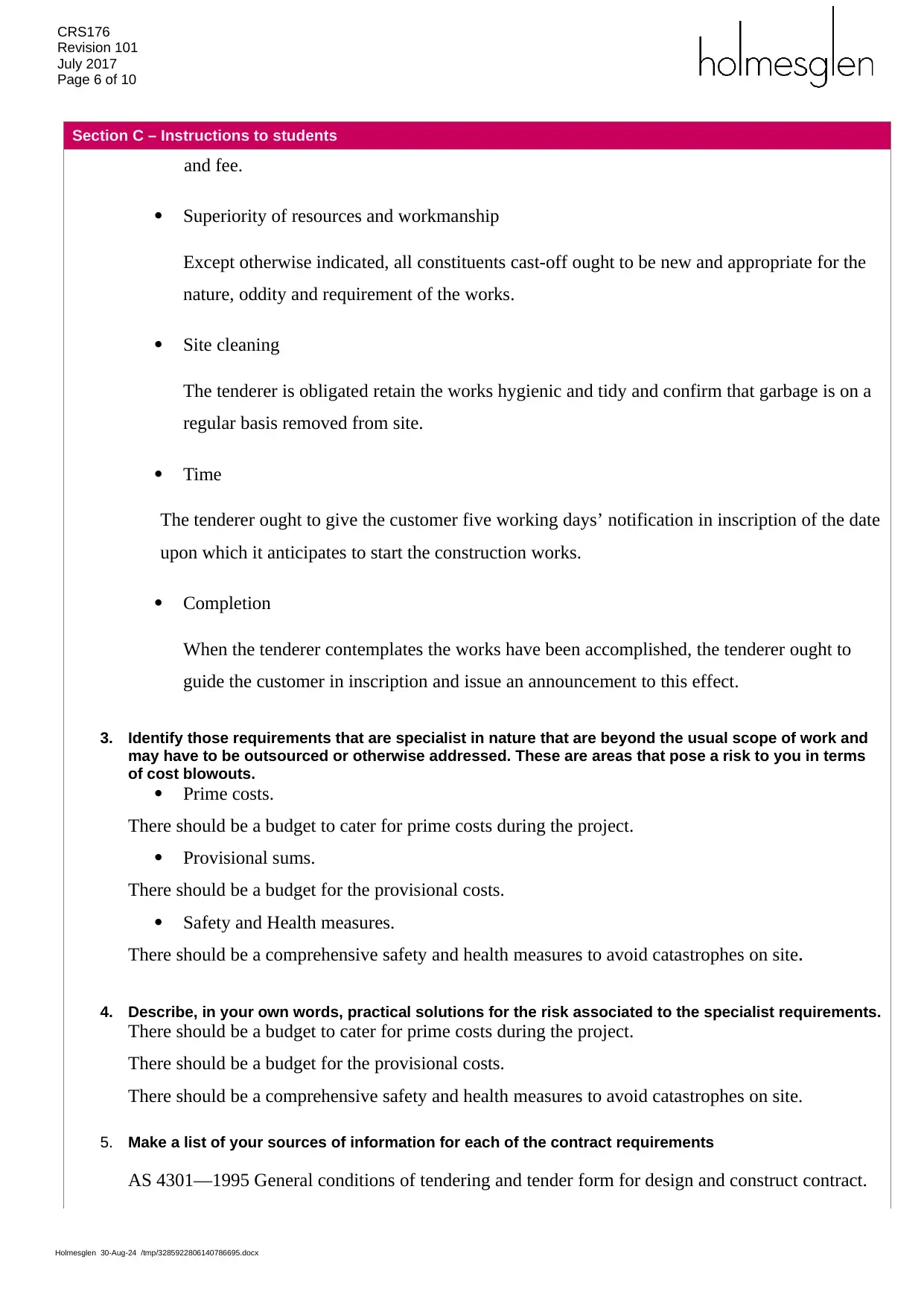
CRS176
Revision 101
July 2017
Page 6 of 10
Section C – Instructions to students
and fee.
Superiority of resources and workmanship
Except otherwise indicated, all constituents cast-off ought to be new and appropriate for the
nature, oddity and requirement of the works.
Site cleaning
The tenderer is obligated retain the works hygienic and tidy and confirm that garbage is on a
regular basis removed from site.
Time
The tenderer ought to give the customer five working days’ notification in inscription of the date
upon which it anticipates to start the construction works.
Completion
When the tenderer contemplates the works have been accomplished, the tenderer ought to
guide the customer in inscription and issue an announcement to this effect.
3. Identify those requirements that are specialist in nature that are beyond the usual scope of work and
may have to be outsourced or otherwise addressed. These are areas that pose a risk to you in terms
of cost blowouts.
Prime costs.
There should be a budget to cater for prime costs during the project.
Provisional sums.
There should be a budget for the provisional costs.
Safety and Health measures.
There should be a comprehensive safety and health measures to avoid catastrophes on site.
4. Describe, in your own words, practical solutions for the risk associated to the specialist requirements.
There should be a budget to cater for prime costs during the project.
There should be a budget for the provisional costs.
There should be a comprehensive safety and health measures to avoid catastrophes on site.
5. Make a list of your sources of information for each of the contract requirements
AS 4301—1995 General conditions of tendering and tender form for design and construct contract.
Holmesglen 30-Aug-24 /tmp/3285922806140786695.docx
Revision 101
July 2017
Page 6 of 10
Section C – Instructions to students
and fee.
Superiority of resources and workmanship
Except otherwise indicated, all constituents cast-off ought to be new and appropriate for the
nature, oddity and requirement of the works.
Site cleaning
The tenderer is obligated retain the works hygienic and tidy and confirm that garbage is on a
regular basis removed from site.
Time
The tenderer ought to give the customer five working days’ notification in inscription of the date
upon which it anticipates to start the construction works.
Completion
When the tenderer contemplates the works have been accomplished, the tenderer ought to
guide the customer in inscription and issue an announcement to this effect.
3. Identify those requirements that are specialist in nature that are beyond the usual scope of work and
may have to be outsourced or otherwise addressed. These are areas that pose a risk to you in terms
of cost blowouts.
Prime costs.
There should be a budget to cater for prime costs during the project.
Provisional sums.
There should be a budget for the provisional costs.
Safety and Health measures.
There should be a comprehensive safety and health measures to avoid catastrophes on site.
4. Describe, in your own words, practical solutions for the risk associated to the specialist requirements.
There should be a budget to cater for prime costs during the project.
There should be a budget for the provisional costs.
There should be a comprehensive safety and health measures to avoid catastrophes on site.
5. Make a list of your sources of information for each of the contract requirements
AS 4301—1995 General conditions of tendering and tender form for design and construct contract.
Holmesglen 30-Aug-24 /tmp/3285922806140786695.docx
⊘ This is a preview!⊘
Do you want full access?
Subscribe today to unlock all pages.

Trusted by 1+ million students worldwide
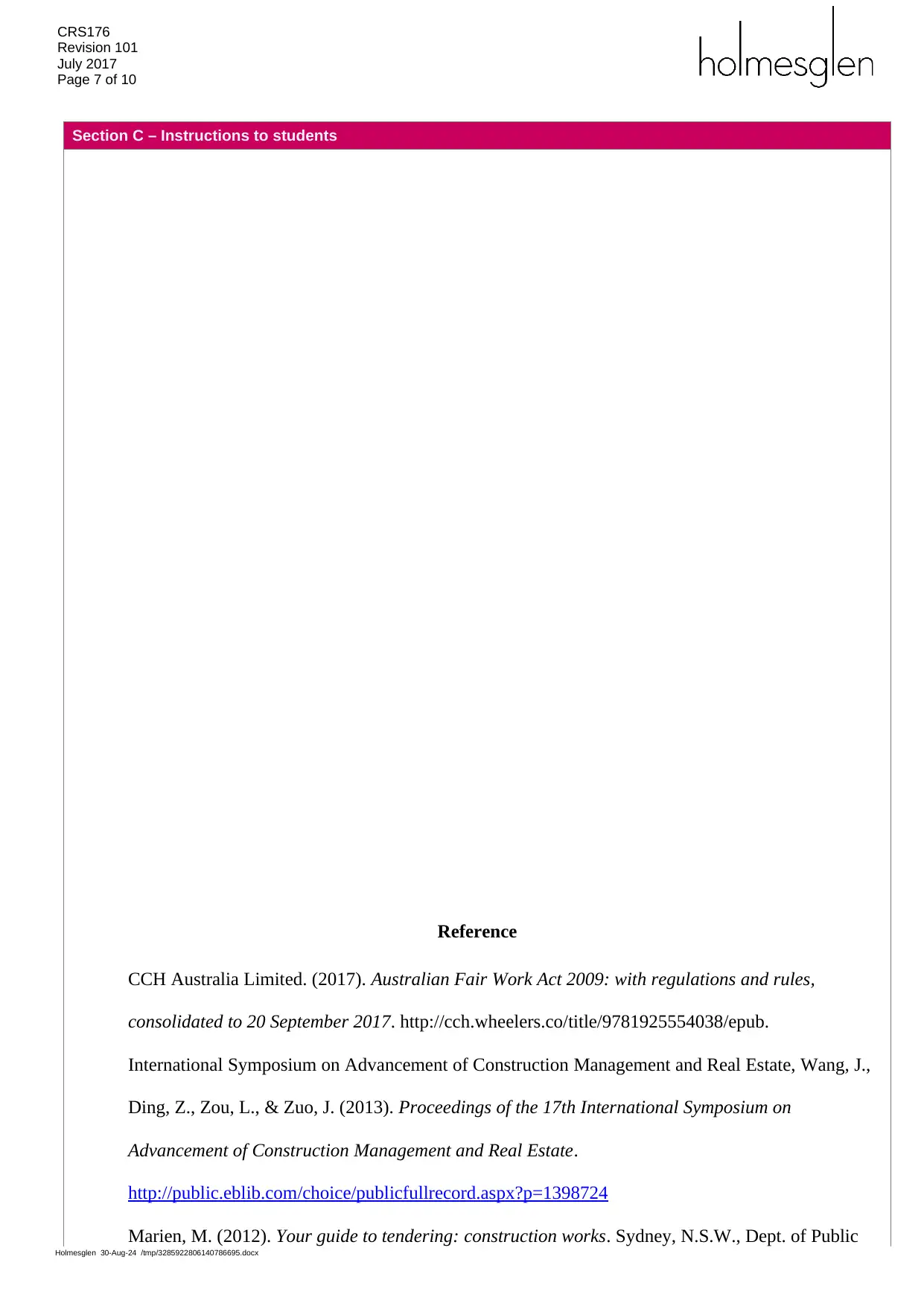
CRS176
Revision 101
July 2017
Page 7 of 10
Section C – Instructions to students
Reference
CCH Australia Limited. (2017). Australian Fair Work Act 2009: with regulations and rules,
consolidated to 20 September 2017. http://cch.wheelers.co/title/9781925554038/epub.
International Symposium on Advancement of Construction Management and Real Estate, Wang, J.,
Ding, Z., Zou, L., & Zuo, J. (2013). Proceedings of the 17th International Symposium on
Advancement of Construction Management and Real Estate.
http://public.eblib.com/choice/publicfullrecord.aspx?p=1398724
Marien, M. (2012). Your guide to tendering: construction works. Sydney, N.S.W., Dept. of Public
Holmesglen 30-Aug-24 /tmp/3285922806140786695.docx
Revision 101
July 2017
Page 7 of 10
Section C – Instructions to students
Reference
CCH Australia Limited. (2017). Australian Fair Work Act 2009: with regulations and rules,
consolidated to 20 September 2017. http://cch.wheelers.co/title/9781925554038/epub.
International Symposium on Advancement of Construction Management and Real Estate, Wang, J.,
Ding, Z., Zou, L., & Zuo, J. (2013). Proceedings of the 17th International Symposium on
Advancement of Construction Management and Real Estate.
http://public.eblib.com/choice/publicfullrecord.aspx?p=1398724
Marien, M. (2012). Your guide to tendering: construction works. Sydney, N.S.W., Dept. of Public
Holmesglen 30-Aug-24 /tmp/3285922806140786695.docx
Paraphrase This Document
Need a fresh take? Get an instant paraphrase of this document with our AI Paraphraser
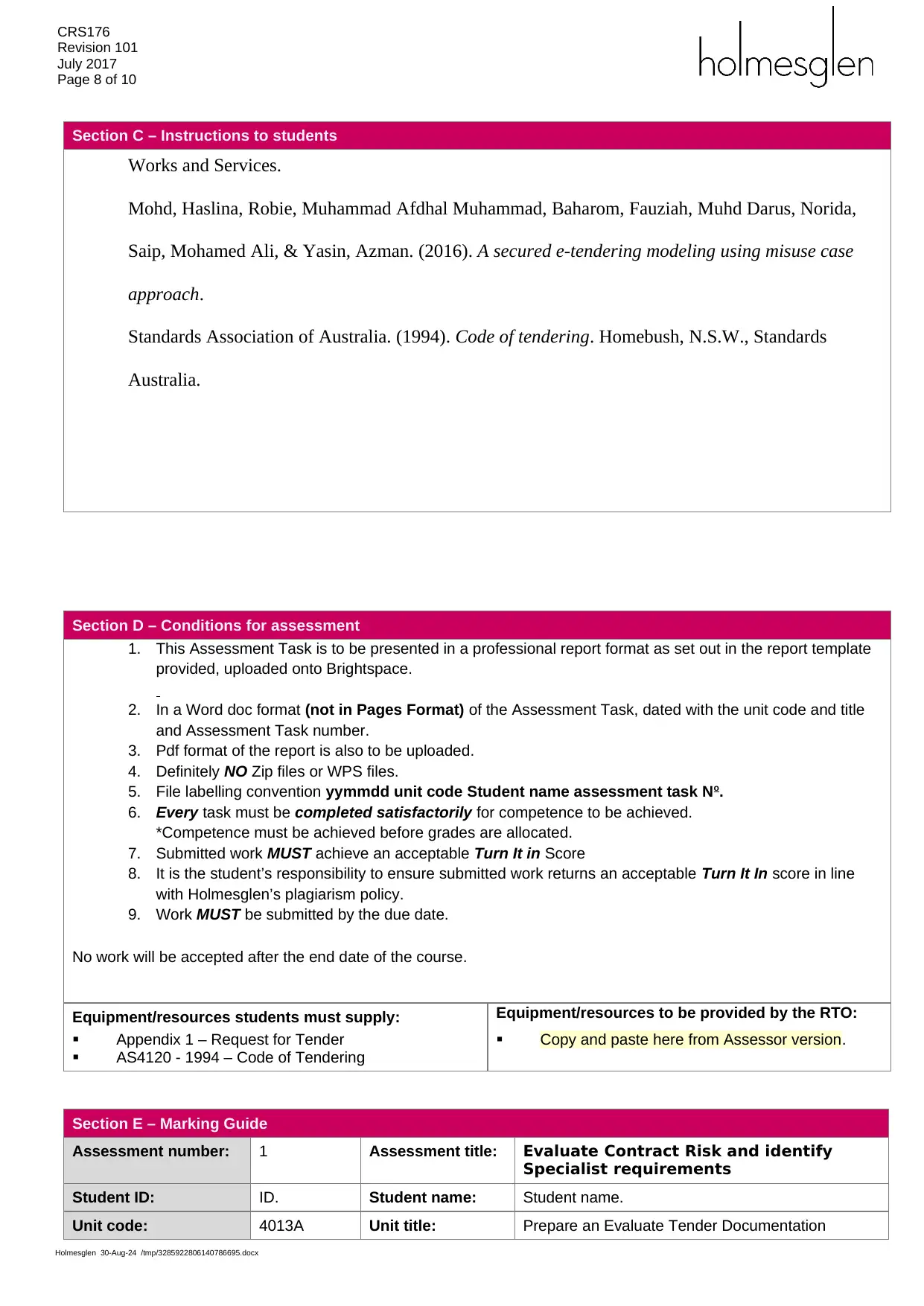
CRS176
Revision 101
July 2017
Page 8 of 10
Section C – Instructions to students
Works and Services.
Mohd, Haslina, Robie, Muhammad Afdhal Muhammad, Baharom, Fauziah, Muhd Darus, Norida,
Saip, Mohamed Ali, & Yasin, Azman. (2016). A secured e-tendering modeling using misuse case
approach.
Standards Association of Australia. (1994). Code of tendering. Homebush, N.S.W., Standards
Australia.
Section D – Conditions for assessment
1. This Assessment Task is to be presented in a professional report format as set out in the report template
provided, uploaded onto Brightspace.
2. In a Word doc format (not in Pages Format) of the Assessment Task, dated with the unit code and title
and Assessment Task number.
3. Pdf format of the report is also to be uploaded.
4. Definitely NO Zip files or WPS files.
5. File labelling convention yymmdd unit code Student name assessment task No.
6. Every task must be completed satisfactorily for competence to be achieved.
*Competence must be achieved before grades are allocated.
7. Submitted work MUST achieve an acceptable Turn It in Score
8. It is the student’s responsibility to ensure submitted work returns an acceptable Turn It In score in line
with Holmesglen’s plagiarism policy.
9. Work MUST be submitted by the due date.
No work will be accepted after the end date of the course.
Equipment/resources students must supply: Equipment/resources to be provided by the RTO:
Appendix 1 – Request for Tender
AS4120 - 1994 – Code of Tendering
Copy and paste here from Assessor version.
Section E – Marking Guide
Assessment number: 1 Assessment title: Evaluate Contract Risk and identify
Specialist requirements
Student ID: ID. Student name: Student name.
Unit code: 4013A Unit title: Prepare an Evaluate Tender Documentation
Holmesglen 30-Aug-24 /tmp/3285922806140786695.docx
Revision 101
July 2017
Page 8 of 10
Section C – Instructions to students
Works and Services.
Mohd, Haslina, Robie, Muhammad Afdhal Muhammad, Baharom, Fauziah, Muhd Darus, Norida,
Saip, Mohamed Ali, & Yasin, Azman. (2016). A secured e-tendering modeling using misuse case
approach.
Standards Association of Australia. (1994). Code of tendering. Homebush, N.S.W., Standards
Australia.
Section D – Conditions for assessment
1. This Assessment Task is to be presented in a professional report format as set out in the report template
provided, uploaded onto Brightspace.
2. In a Word doc format (not in Pages Format) of the Assessment Task, dated with the unit code and title
and Assessment Task number.
3. Pdf format of the report is also to be uploaded.
4. Definitely NO Zip files or WPS files.
5. File labelling convention yymmdd unit code Student name assessment task No.
6. Every task must be completed satisfactorily for competence to be achieved.
*Competence must be achieved before grades are allocated.
7. Submitted work MUST achieve an acceptable Turn It in Score
8. It is the student’s responsibility to ensure submitted work returns an acceptable Turn It In score in line
with Holmesglen’s plagiarism policy.
9. Work MUST be submitted by the due date.
No work will be accepted after the end date of the course.
Equipment/resources students must supply: Equipment/resources to be provided by the RTO:
Appendix 1 – Request for Tender
AS4120 - 1994 – Code of Tendering
Copy and paste here from Assessor version.
Section E – Marking Guide
Assessment number: 1 Assessment title: Evaluate Contract Risk and identify
Specialist requirements
Student ID: ID. Student name: Student name.
Unit code: 4013A Unit title: Prepare an Evaluate Tender Documentation
Holmesglen 30-Aug-24 /tmp/3285922806140786695.docx
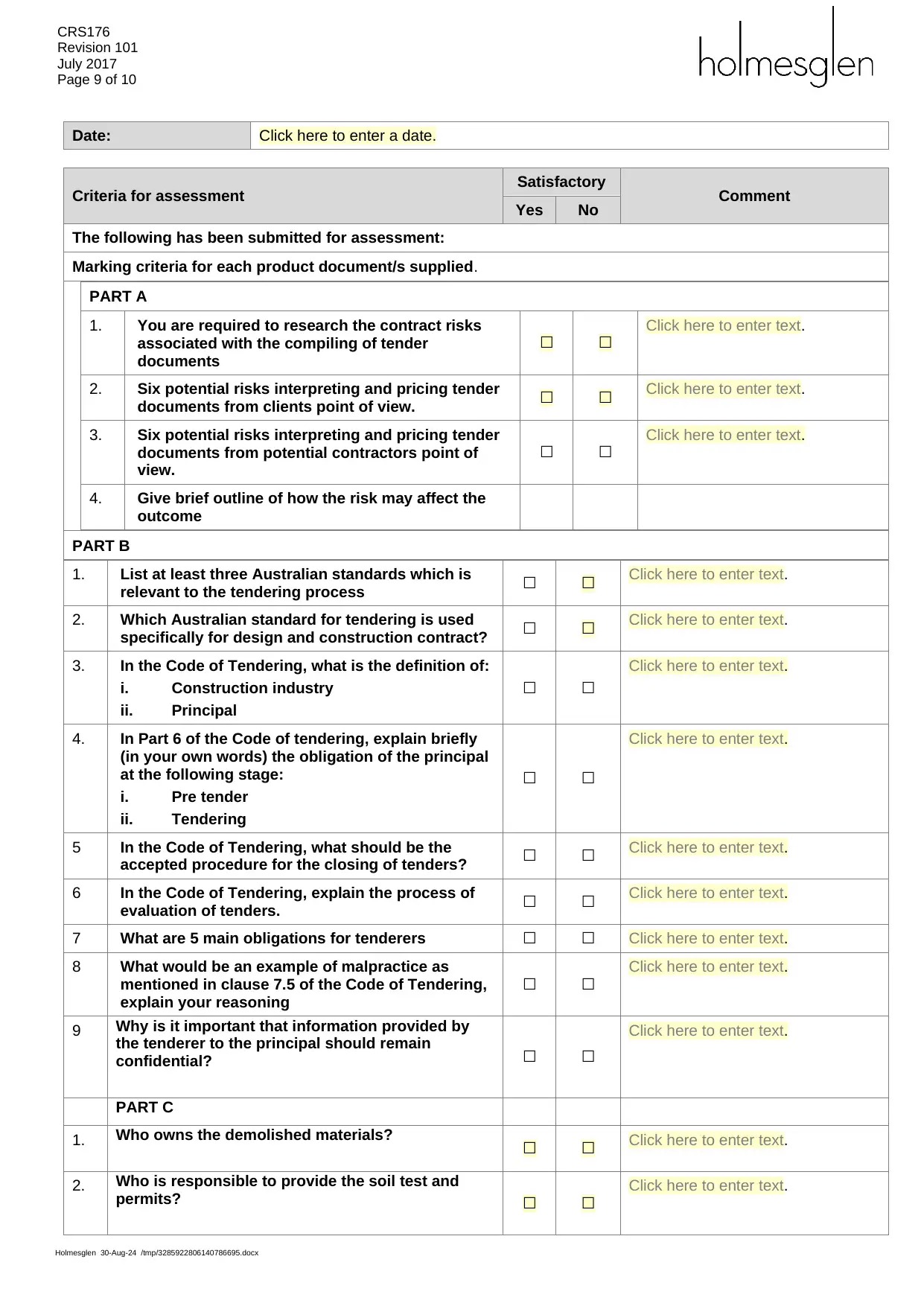
CRS176
Revision 101
July 2017
Page 9 of 10
Date: Click here to enter a date.
Criteria for assessment Satisfactory Comment
Yes No
The following has been submitted for assessment:
Marking criteria for each product document/s supplied.
PART A
1. You are required to research the contract risks
associated with the compiling of tender
documents
☐ ☐
Click here to enter text.
2. Six potential risks interpreting and pricing tender
documents from clients point of view. ☐ ☐ Click here to enter text.
3. Six potential risks interpreting and pricing tender
documents from potential contractors point of
view.
☐ ☐
Click here to enter text.
4. Give brief outline of how the risk may affect the
outcome
PART B
1. List at least three Australian standards which is
relevant to the tendering process ☐ ☐ Click here to enter text.
2. Which Australian standard for tendering is used
specifically for design and construction contract? ☐ ☐ Click here to enter text.
3. In the Code of Tendering, what is the definition of:
i. Construction industry
ii. Principal
☐ ☐
Click here to enter text.
4. In Part 6 of the Code of tendering, explain briefly
(in your own words) the obligation of the principal
at the following stage:
i. Pre tender
ii. Tendering
☐ ☐
Click here to enter text.
5 In the Code of Tendering, what should be the
accepted procedure for the closing of tenders? ☐ ☐ Click here to enter text.
6 In the Code of Tendering, explain the process of
evaluation of tenders. ☐ ☐ Click here to enter text.
7 What are 5 main obligations for tenderers ☐ ☐ Click here to enter text.
8 What would be an example of malpractice as
mentioned in clause 7.5 of the Code of Tendering,
explain your reasoning
☐ ☐
Click here to enter text.
9 Why is it important that information provided by
the tenderer to the principal should remain
confidential? ☐ ☐
Click here to enter text.
PART C
1. Who owns the demolished materials? ☐ ☐ Click here to enter text.
2. Who is responsible to provide the soil test and
permits? ☐ ☐
Click here to enter text.
Holmesglen 30-Aug-24 /tmp/3285922806140786695.docx
Revision 101
July 2017
Page 9 of 10
Date: Click here to enter a date.
Criteria for assessment Satisfactory Comment
Yes No
The following has been submitted for assessment:
Marking criteria for each product document/s supplied.
PART A
1. You are required to research the contract risks
associated with the compiling of tender
documents
☐ ☐
Click here to enter text.
2. Six potential risks interpreting and pricing tender
documents from clients point of view. ☐ ☐ Click here to enter text.
3. Six potential risks interpreting and pricing tender
documents from potential contractors point of
view.
☐ ☐
Click here to enter text.
4. Give brief outline of how the risk may affect the
outcome
PART B
1. List at least three Australian standards which is
relevant to the tendering process ☐ ☐ Click here to enter text.
2. Which Australian standard for tendering is used
specifically for design and construction contract? ☐ ☐ Click here to enter text.
3. In the Code of Tendering, what is the definition of:
i. Construction industry
ii. Principal
☐ ☐
Click here to enter text.
4. In Part 6 of the Code of tendering, explain briefly
(in your own words) the obligation of the principal
at the following stage:
i. Pre tender
ii. Tendering
☐ ☐
Click here to enter text.
5 In the Code of Tendering, what should be the
accepted procedure for the closing of tenders? ☐ ☐ Click here to enter text.
6 In the Code of Tendering, explain the process of
evaluation of tenders. ☐ ☐ Click here to enter text.
7 What are 5 main obligations for tenderers ☐ ☐ Click here to enter text.
8 What would be an example of malpractice as
mentioned in clause 7.5 of the Code of Tendering,
explain your reasoning
☐ ☐
Click here to enter text.
9 Why is it important that information provided by
the tenderer to the principal should remain
confidential? ☐ ☐
Click here to enter text.
PART C
1. Who owns the demolished materials? ☐ ☐ Click here to enter text.
2. Who is responsible to provide the soil test and
permits? ☐ ☐
Click here to enter text.
Holmesglen 30-Aug-24 /tmp/3285922806140786695.docx
⊘ This is a preview!⊘
Do you want full access?
Subscribe today to unlock all pages.

Trusted by 1+ million students worldwide
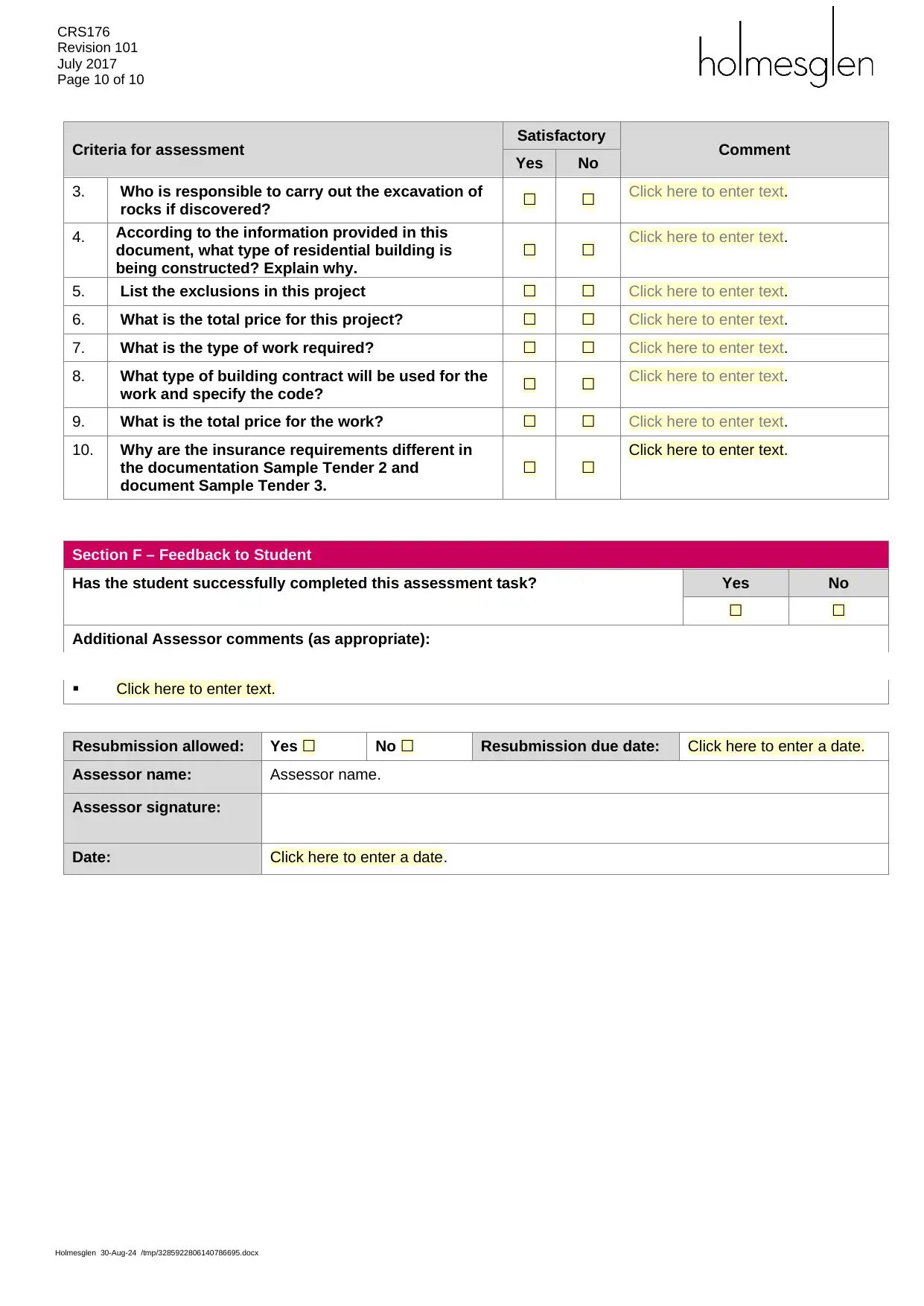
CRS176
Revision 101
July 2017
Page 10 of 10
Criteria for assessment Satisfactory Comment
Yes No
3. Who is responsible to carry out the excavation of
rocks if discovered? ☐ ☐ Click here to enter text.
4. According to the information provided in this
document, what type of residential building is
being constructed? Explain why.
☐ ☐ Click here to enter text.
5. List the exclusions in this project ☐ ☐ Click here to enter text.
6. What is the total price for this project? ☐ ☐ Click here to enter text.
7. What is the type of work required? ☐ ☐ Click here to enter text.
8. What type of building contract will be used for the
work and specify the code? ☐ ☐ Click here to enter text.
9. What is the total price for the work? ☐ ☐ Click here to enter text.
10. Why are the insurance requirements different in
the documentation Sample Tender 2 and
document Sample Tender 3.
☐ ☐
Click here to enter text.
Section F – Feedback to Student
Has the student successfully completed this assessment task? Yes No
☐ ☐
Additional Assessor comments (as appropriate):
Click here to enter text.
Resubmission allowed: Yes ☐ No ☐ Resubmission due date: Click here to enter a date.
Assessor name: Assessor name.
Assessor signature:
Date: Click here to enter a date.
Holmesglen 30-Aug-24 /tmp/3285922806140786695.docx
Revision 101
July 2017
Page 10 of 10
Criteria for assessment Satisfactory Comment
Yes No
3. Who is responsible to carry out the excavation of
rocks if discovered? ☐ ☐ Click here to enter text.
4. According to the information provided in this
document, what type of residential building is
being constructed? Explain why.
☐ ☐ Click here to enter text.
5. List the exclusions in this project ☐ ☐ Click here to enter text.
6. What is the total price for this project? ☐ ☐ Click here to enter text.
7. What is the type of work required? ☐ ☐ Click here to enter text.
8. What type of building contract will be used for the
work and specify the code? ☐ ☐ Click here to enter text.
9. What is the total price for the work? ☐ ☐ Click here to enter text.
10. Why are the insurance requirements different in
the documentation Sample Tender 2 and
document Sample Tender 3.
☐ ☐
Click here to enter text.
Section F – Feedback to Student
Has the student successfully completed this assessment task? Yes No
☐ ☐
Additional Assessor comments (as appropriate):
Click here to enter text.
Resubmission allowed: Yes ☐ No ☐ Resubmission due date: Click here to enter a date.
Assessor name: Assessor name.
Assessor signature:
Date: Click here to enter a date.
Holmesglen 30-Aug-24 /tmp/3285922806140786695.docx
1 out of 10
Your All-in-One AI-Powered Toolkit for Academic Success.
+13062052269
info@desklib.com
Available 24*7 on WhatsApp / Email
![[object Object]](/_next/static/media/star-bottom.7253800d.svg)
Unlock your academic potential
Copyright © 2020–2025 A2Z Services. All Rights Reserved. Developed and managed by ZUCOL.
